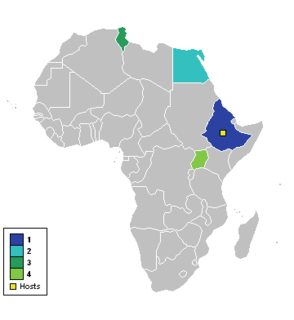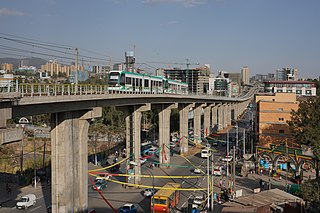
Italian East Africa was an Italian colony in the Horn of Africa. It was formed in 1936 through the merger of Italian Somaliland, Italian Eritrea, and the newly occupied Ethiopian Empire which became Italian Ethiopia.

The 1962 Africa Cup of Nations was the third edition of the Africa Cup of Nations, the soccer championship of Africa (CAF). It was hosted by Ethiopia. Nine countries entered the competition, including the reigning champions Egypt, meaning for the first time a qualification tournament was required. The finals only included four teams. Egypt, as holders, and Ethiopia as hosts, qualified automatically meaning each needed to play only one game to reach the final. Ethiopia won the tournament for the first time after extra time in the final.

Addis Ababa Bole International Airport is in the city of Addis Ababa, Ethiopia. It is located in the Bole area, 6 km (3.7 mi) southeast of the city centre and 65 km (40 mi) north of Debre Zeyit. The airport was formerly known as Haile Selassie I International Airport. It is the main hub of Ethiopian Airlines, the national airline that serves destinations in Ethiopia and throughout the African continent, as well as nonstop service to Asia, Europe, North America and South America. The airport is also the base of the Ethiopian Aviation Academy. As of June 2018, nearly 450 flights per day were departing from and arriving at the airport.

Dire Dawa is one of two chartered cities in Ethiopia. It is divided administratively into two woredas, the city proper and the non-urban woreda of Gurgura.

Rail transport in Ethiopia is done within the National Railway Network of Ethiopia, which currently consists of three electrified standard gauge railway lines: the Addis Ababa–Djibouti Railway, the Awash–Weldiya Railway and the Weldiya–Mekelle Railway. Other lines are still in the planning phase. There is also a metro system in the country's capital, the Addis Ababa Light Rail.

Addis Ababa Stadium is a multi-purpose stadium in Addis Ababa, Ethiopia. It is used mostly for football matches although it also has athletics facilities. The stadium has a capacity of 35,000 people.

The mass media in Ethiopia consist of radio, television and the Internet, which remain under the control of the Ethiopian government, as well as private newspapers and magazines. Ten radio broadcast stations, eight AM and two shortwave, are licensed to operate in Ethiopia. The major radio broadcasting stations include Raido Ethiopia, Radio Fana a private station, Radio Voice of One Free Ethiopia, and the Voice of the Revolution of Tigray. The only terrestrial (broadcast) television networks are government owned and include Ethiopian Television and other regional stations. In keeping with government policy, radio broadcasts occur in a variety of languages including Amharic, Afaan Oromo, Tigrigna, and more. There are also many video sharing websites which are a popular way of getting information as well as entertainment in Ethiopia.

The Ethiopian Catholic Archeparchy of Addis Ababa, officially the Metropolitan sui iuris Archeparchy of Addis Ababa is the metropolitan see of the Ethiopian Catholic Church, a sui iuris metropolitan Eastern Catholic Church.
Sebeta is a town and separate woreda in central Ethiopia, and a suburb of Addis Ababa. Located in the Oromia Special Zone Surrounding Finfinne of the Oromia Region, this town has a latitude and longitude of 8°54′40″N38°37′17″E and an elevation of 2,356 meters above sea level.

Holeta Genet is a town and separate woreda in central Ethiopia. Located in the Oromia Special Zone Surrounding Finfinne of the Oromia Region, it has a latitude and longitude of 9°3′N38°30′E and an altitude of 2391 meters above sea level.

The Ethio-Djibouti Railway (French: Chemin de Fer Djibouto-Éthiopien is a metre gauge railway in the Horn of Africa that once connected Addis Ababa to the port city of Djibouti. The operating company was also known as the Ethio-Djibouti Railways. The railway was built in 1894–1917 to connect the Ethiopian capital city to the then-French colony of Djibouti. During early operations, it provided landlocked Ethiopia with its only access to the sea. After World War II, the railway progressively fell into a state of disrepair due to competition from road transport.

Meskel Square is a square in the city of Addis Ababa, Ethiopia. It is often a site for public gathering or for demonstrations and festivals, notably, the Meskel Festival from which it takes its name.

Ethiopia–Mexico relations refers to the diplomatic relations between Ethiopia and Mexico.

Italian Ethiopia was a short-lived enterprise to create a colony of the Kingdom of Italy located in East Africa, on the territory of Ethiopia. It was proclaimed in 1936 following the second Italo-Ethiopian War in which the Ethiopian Empire was occupied by Benito Mussolini's Fascist Italy. It became part of Italian East Africa, with its capital moved to Addis Ababa and Victor Emmanuel III proclaiming himself Emperor of Ethiopia.

Meyazia 27 Square is an important and historic intersection and surrounding neighborhood in Addis Ababa, located where Adwa St, King George VI St, Queen Elizabeth II St, and Development Through Cooperation Ave come together. Its name denotes both the day when Addis Ababa fell to Italy in 1936 and was liberated in 1941. The park is under the aegis of the Addis Ababa Land Development and Urban Renewal Agency.

Legehar train station, or La Gare, was the main railway station in Addis Ababa, Ethiopia, the terminal station of the first Addis Ababa – Djibouti train line in the Horn of Africa. Completed in 1917, the station was a central part of the city and the main source of traffic into the city. The style of the station is French with meter-gauge track being used.




















